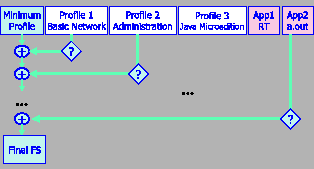

In table 1 there are shown the required profiles according to the
application needs.
| Processor | 386 or up * |
|---|---|
| RAM | 4 Mb or up |
| Boot device (one of the next) | |
| Network card with bootp | |
| temporal connection floppy disk | |
| No volatile memory | |
| (Serial port) | |
| File system capacity | |
| Minimal real time execution support | 114 Kb |
| Modular real time execution support | (+) 600 Kb |
| Network | (+) 430 Kb |
| On site admin-utilities | (+) 600 Kb |
| On site debugging | (+) 3.3 Mb |
| Java 2 Micro-edition | (+) 2 Mb |
| Java standard | (+) 25 Mb |